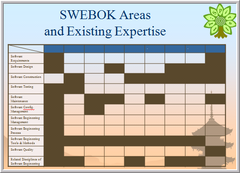What is special about IT Spiral?
IT SPIRAL intends to develop top-level software engineers with technical background for the long term. It deliberately focuses on selecting talented students and encouraging world-class software development activity. It provides systematic software engineering education. One of the key realizations in developing the collaborative curriculum has been that it is not enough for students to know that they can use a particular method to develop something or that they use some tool in a particular way. Instead, IT SPIRAL encourages students to ask why this method works, and are there any other ways to do things. This shift from knowledge, comprehension, and application -- Bloom's lower levels -- to analysis, evaluation, synthesis and even further into creativity and transfer into new domains of thought [2] has not been easy, but it is considered a necessary part of the new curriculum, as shown in Figure 2. Appendix D of the Guide to the Software Engineering Body of Knowledge (SWEBOK) described Bloom's Taxonomy [3].
Three elements help to develop the desired talent. First, the project involves top educators, researchers, and industry leaders in the Kansai area. Second, the project is selective, with 40 top-quality students each year. Third, the curriculum and materials were developed for this purpose drawing on resources of all nine universities and four industries.
The curriculum builds on three core concepts. It begins by systematically teaching fundamental subjects related to software development, the basic skills of software engineering. It also teaches new trends, techniques, and research with the theories behind them, to encourage the capability of continuous learning and adaptation. Finally, the curriculum provides practical development opportunities, encouraging practical skills.
The classes also reflect this threefold division. Each graduate school assigns and teaches fundamental software engineering subjects to students at their university. Faculty from all of the universities have developed a shared library of DVD lectures and associated exercises or materials on advanced software engineering subjects, which each university can use in their own way to enhance the software engineering education for their students. During the first year, this produced 60 one-hour lectures organized into 12 volumes focusing on various advanced topics such as:
| Code Clones | MCU Architectures | Agile Methods | Software Patterns |
| UML design | Data Mining | Real-Time Software | Web-based software |
| Meta-modeling | Software repositories | Components | Frameworks |
Finally, industry lecturers with university teaching assistants teach the practical software engineering subjects. These sessions are especially important because they bring the real world of software engineering into the academic programs and challenge the students [4]. The students from all nine universities go to Nakanoshima Center, a common meeting point, for six hours of intensive work on alternative Fridays. Figure 3 shows the students at work during the common intensive session. The DVD library and intensive sessions reflect the reversal of the lecture/homework paradigm, since the DVDs can be watched whenever convenient, allowing the intensive sessions to focus on questions, exercises, and problem-based learning [5].
IT SPIRAL used the Computing Curricula 2005 (CC 2005) [6] and SWEBOK [3] materials extensively during design of the curriculum. One of the areas of discussion during the curriculum design process looked at the existing expertise in the 10 SWEBOK areas. Figure 4 shows the mapping of expertise by the various universities against those areas. This helped identify, for example, the two schools that could provide materials and expertise in software requirements. The university names have been removed from the column headings in this chart to protect confidentiality.
While there are known concerns about the SWEBOK and CC 2005 recommendations [1], these were available while IT SPIRAL was developing. IT SPIRAL intends to participate in the new Graduate Software Engineering Reference Curriculum project (GSwERC) [7].
IT SPIRAL can also be considered in terms of pedagogical frameworks such as that of the National Survey of Student Engagement [8]. Although the measures are informal, IT SPIRAL has set high expectations for student achievement (level of academic challenge). The three branches of the IT SPIRAL curriculum encourage student involvement with the educational process, and application of knowledge in various situations (Active and collaborative learning). Industry experts, teaching assistants, and faculty interact with the students as role models and mentors (Student-faculty interaction). The varied learning opportunities clearly enhance the educational environment of IT SPIRAL (Enriching educational experience). Finally, the universities involved promote involvement in the program (supportive campus environment).
- [1] A.Pyster, R. Turner, D. Henry, K. Lasfer, L. Bernstein. "The Current State of Software Engineering Masters Degree Programs." Proceedings, 21st Conference on Software Engineering Education and Training, April 2008, pp. 103-109.
- [2] N. Stankovic. "Single Development Project." Proceedings, 21st Conference on Software Engineering Education and Training, April 2008, pp. 171-178
- [3] A. Abran, J. W. Moore, P. Bourque, R. Dupuis. Guide to the Software Engineering Body of Knowledge: 2004 Edition - SWEBOK. IEEE Computer Society. April 2005.
- [4] W. L. Honig "Teaching Successful 'Real-World' Software Engineering to the 'Net' Generation: Process and Quality Win!" Proceedings, 21st Conference on Software Engineering Education and Training, April 2008, pp.25-32.
- [5] J. Foertsch, G. Moses, J. Strikwerda, M. Litzkow. "Reversing the lecture / homework paradigm using eTEACH Web-based streaming video software." Journal of Engineering Education, July 2002, pp. 267-274.
- [6] ACM. Computing Curricula 2005: The Overview Report. September 2005.
- [7] A. Pyster. Graduate Software Engineering Reference Curriculum [GSwERC] Version 0.50, Stevens Institute of Technology, October 2008.
- [8] K.A. Smith, S.D. Sheppard, D.W. Johnson, R.T. Johnson. "Pedagogies of Engagement: Classroom-Based Practices." Journal of Engineering Education, January 2005, pp. 87-101.


